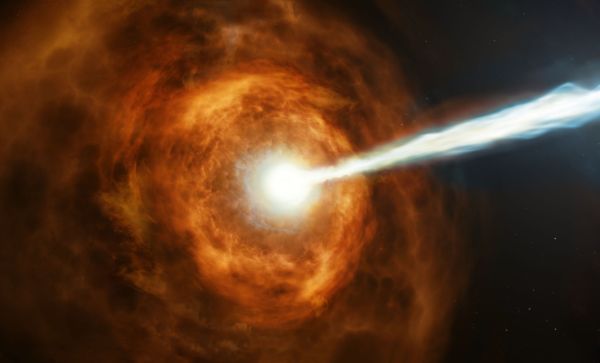Energy burst from most distant known galaxy might have been a satellite orbiting Earth


The cosmos is the stage for a variety of giant explosions. These include stellar flares, where stars suddenly release magnetic energy; and neutron star mergers, where two dense stars collide together. But one class of explosions outshines the rest: Gamma ray bursts are the most energetic explosions seen in the universe.
Gamma rays are one of the most energetic forms of light, and gamma ray bursts release almost unimaginable quantities of them. First discovered during the Cold War – by military satellites searching for the signs of nuclear tests in the upper atmosphere – gamma ray bursts are now thought to be caused by massive stars undergoing huge explosions when they run out of fuel. These events are rare, but so energetic they can be seen in galaxies many billions of light years away.
Recently, astronomers thought they had seen evidence for one of these explosions from the most distant galaxy every seen. But a recently published paper casts doubt on these claims, suggesting it might have been caused by a more mundane source much closer to home.
Gamma ray bursts
No gamma ray bursts have been documented in our galaxy yet, which may not be a bad thing. A gamma ray burst pointed directly at the Earth would probably lead to a mass extinction event, and the end of civilisation as we know it. Undocumented events may in fact already have caused mass extinction events in Earth’s history.
Gamma ray bursts have been seen far away, however. The paper suggesting researchers had discovered a new gamma ray burst in the most distant known galaxy was published in 2020. Using the Keck telescope on Mauna Kea, Hawaii, the researchers observed strips of the sky, and happened to see a bright flash, just a few seconds long, in one of their exposures.
By modelling the duration and brightness of the flash, they ruled out the possibility that it was a natural or human-made satellite close to home. They also ruled out a number of other astronomical explanations, and concluded that the most likely explanation was, indeed, a gamma ray burst.
What was so unique about this discovery was that the team pinpointed the direction of the event and found it was coming from the same area as a galaxy known as GN-z11, which just so happens to be the most distant and oldest galaxy we’ve yet discovered.
Get the world’s most fascinating discoveries delivered straight to your inbox.
Was this an incredible cosmic coincidence? Or was this a sign that gamma ray bursts were more common in the very early universe, just 400 million years after the big bang? The latter conclusion would have big implications for our understanding of how stars and galaxies form in the early universe, and led to a lot of excitement among astronomers.
But unease about the conclusions of the group surfaced, with some arguing it was much more likely that the flash was from an object within our solar system, which could be a natural (such as a moon) or artificial satellite. In another paper, a different team suggested the most likely explanation was a reflection from a human-made satellite. The original authors followed up on these claims, doubling down on their gamma ray burst interpretation, but the chorus of doubters was only getting louder.
Space junk
Now, the controversy has taken another turn, with a new paper recently published in Nature. The authors of this paper suggest the purported gamma-ray burst was in fact a flash caused by a human-made satellite after all. The researchers used a public space-track website to search for possible human satellite interference in the direction and at the time of the flash detection.
Around the time that the original team were studying the sky, a Russian proton rocket reached low Earth orbit and released its upper stages (dubbed Breeze-M), which then became space junk, orbiting the Earth. By looking at the orbit of the space debris and matching with the observations taken in the original study, the new team found the flash could be simply explained by the upper stage falling past the part of the sky the telescope was observing.
Read more: The Sun's atmosphere is hundreds of times hotter than its surface – here's why
The proton rocket has been in operation since the 1960s, and it’s not the only time one of its Breeze-M upper stages has been in the news. In 2013 an explosion scattered huge amounts of debris into near Earth orbit, and left NASA scrambling to assess whether it would pose a danger to the International Space Station.
While this particular incident was perhaps particularly unlucky, with increasing amounts of junk in space, and the launching of large constellations of satellites by the private company SpaceX and others in the coming years, it highlights the increasing difficulties astronomers face observing from the Earth’s surface.
Better databases of satellites and space debris will help avoid these kinds of misidentifications. But the increasing light pollution from satellite constellations threatens the ability of telescopes on the ground to even see clearly enough to do world-leading science.
This article is republished from The Conversation under a Creative Commons license. Read the original article.
Follow all of the Expert Voices issues and debates — and become part of the discussion — on Facebook and Twitter. The views expressed are those of the author and do not necessarily reflect the views of the publisher.



